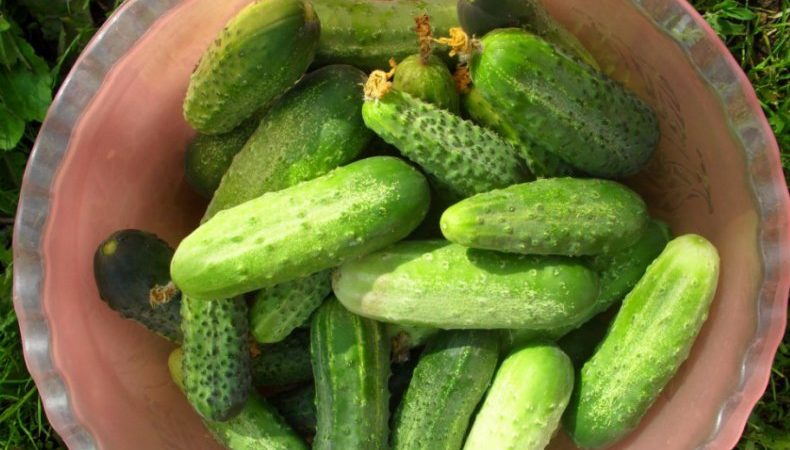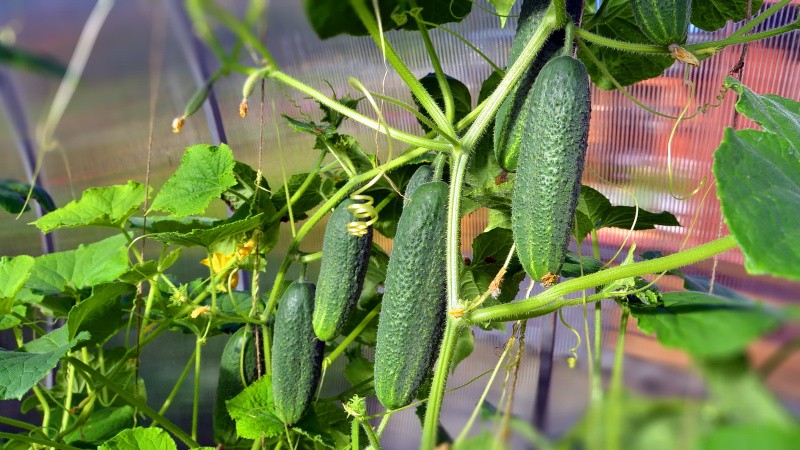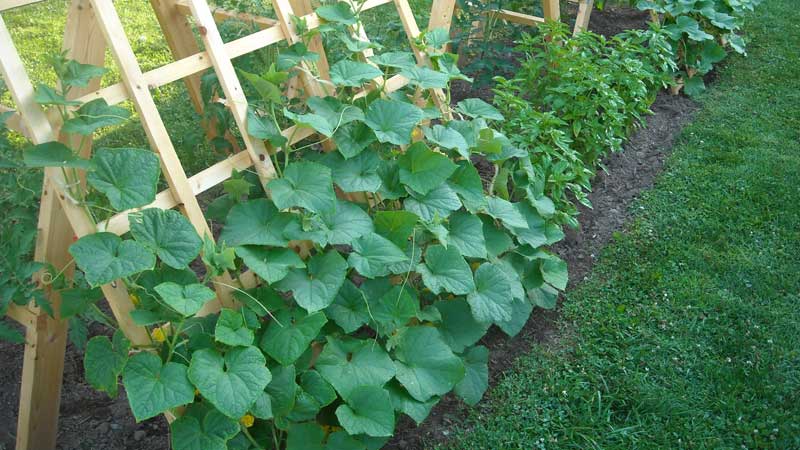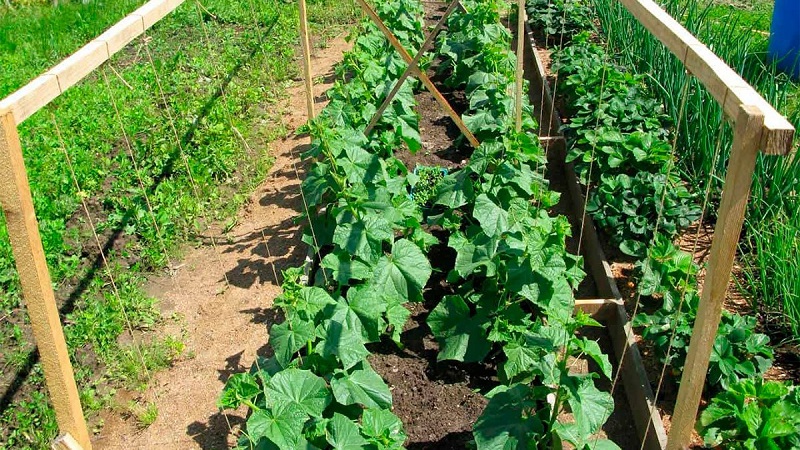The best Dutch cucumber varieties for greenhouses and open ground
Dutch varieties and hybrids of cucumbers are deservedly popular. High yields, immunity to disease, excellent taste are all about them. We offer you to get acquainted with the variety of "Dutch" and recommendations for their cultivation.
The content of the article
Features of Dutch cucumbers
Dutch cucumbers are characterized by the following features:
- High percentage of seed germination.
- High yield guaranteed.
- Resistance - innate immunity - to fungi, viruses, bacteria.
- Lack of bitterness in the pulp.
- Presentable appearance - fruits are mostly of the same size.
- Fresh food and home canning. Most processed varieties remain firm and crunchy.
- Good transportability, during transportation the fruits retain their presentation.
How do they differ from domestic

By crossing strong varieties, Dutch breeders develop hybrids that have excellent taste and disease resistance.... The disadvantage of this method is the need to buy seeds, since it is impossible to independently collect seed material from hybrids - the declared qualities will be lost.
Dutch cucumbers are mostly self-pollinated. Thanks to this, vegetables can be grown both in greenhouse conditions and in the open field. Pollinated cucumbers have a richer flavor and more crunch when canning.
Best Dutch Cucumbers
Breeders have created many hybrids with a variety of characteristics. The most popular and demanded ones are presented below.
Prestige F1
Early ripe hybrid (detail) with parthenocarpic type of pollination. The growing season is 40 days. Suitable for breeding in open and closed ground.
Seeds are sown from March to July, fruiting occurs from May to October, respectively.
Fruit length - 10-12 cm, weight - up to 95 g. Fruits do not outgrow.
The yield is high - up to 20 kg per 1 sq. m.
Resistant to changing climatic conditions.
Pioneer F1
Parthenocarpic hybrid, mid-season - the first harvest is ready for harvest 45-55 days after seed germination... Grown in seedlings.
Cucumber length - 8-12 cm, weight - up to 85 g.
Productivity - up to 6 kg per 1 sq. m. The number of fruits is limited, but the yield is constant.
Resistant to adverse conditions.
Sonata F1
Early maturing, bee-pollinated hybrid. Begins to bear fruit 40-43 days after the shoots appear. Grown in the open field.
The seeds are sown in March, the harvest is harvested in June. For late harvest in October, sow in July.
Cucumber length - 8-10 cm, weight 80-90 g. Productivity - up to 11 kg per 1 sq. m.
We tolerate unfavorable conditions.
Crispin F1
Early maturing parthenocarpic hybrid (detail). Suitable for fruiting in greenhouses and open ground.
Sowing is done in April, the first crop is harvested in June. Cucumber length - up to 12 cm, weight - about 85-110 g.
Productivity - up to 10 kg per 1 sq. m.
F1 Pro
Early maturing parthenocarpic hybrid. Harvesting is possible 38-40 days after germination. Suitable for indoor and outdoor use. It has a powerful root system.
Fruit length - up to 8 cm.
Herman F1
Early maturing self-pollinated hybrid (detail)... The growing season is 38-44 days.It is grown both in greenhouse conditions and in open beds.
The right time for planting is May. Harvested from July to August.
Fruit length - 9-11 cm, weight - up to 95 g.
Productivity - from 8 to 10 kg per 1 sq. m.
We tolerate short-term cold snaps, not adapted to prolonged dry weather.
Dolomite F1
Self-pollinated hybrid of early ripening. The growing season is 36-41 days. It is grown in open and closed ground conditions.
Seeds are sown in March. The fruiting period is from mid-July to mid-October.
Fruit length - 9-14 cm, weight - up to 100 g.
Productivity - up to 7 kg per 1 sq. m.
Able to quickly recover from drought and cold weather.
Bettina F1
Early maturing self-pollinated hybrid (detail). Fruit ripening period is 38-42 days. Suitable for growing in greenhouses and on balconies. Can grow in shade.
Cucumbers are sown from March to July, the harvest is harvested from May to October.
Cucumbers grow up to 8 cm in length, weighing 65-75 g.
Important! This hybrid is hygrophilous. It also needs to be fed with potash fertilizers.
Productivity - 5-6 kg per 1 sq. m. The bulk of the crop ripens in the first month of fruiting.
Angelina F1
Early maturing parthenocarpic hybrid. The first cucumbers ripen from 40 to 45 days after seed germination. It bears fruit both in open ground and in greenhouses.
Attention! The hybrid is also grown in winter and spring in heated greenhouses.
Sowing begins in April, the first greens are ready for harvest in July.
Fruit length varies from 9 to 13 cm, weight - in the range of 80-110 g.
We tolerate a lack of sunlight, but needs warmth, moisture and nutrient composition of the soil.
Mirabell F1
Early ripe hybrid-parthenocarpic (detail)... Ripening period is 40-45 days. Suitable for growing both in greenhouse conditions and in the open field.
In May, seeds are sown in open ground, the harvest is harvested in July and August.
Cucumber length - up to 10 cm, weight - up to 100 g.
Productivity - 20-24 kg per 1 sq. m.
How to choose Dutch cucumbers
Dutch cucumbers are classified by pollination method, growing and ripening times, and cultivation method.
Self-pollinated
In the process of ovary formation, such plants do not require the participation of insects. The flower has female pistils and male stamens, pollinating independently.
Self-pollinated cucumbers grow powerful and resistant to many diseases, bear fruit for a long time.
Self-pollinated cucumber seeds are suitable for cultivation in greenhouses, although they also grow well in unprotected beds. Before sowing, organic or mineral fertilizers are applied to the soil.
An example of self-pollinated cucumbers: Angelina F1, Hector F1, Prestige F1, Herman F1 and others.
Bee-pollinated
The ovaries of such cucumbers are formed only when pollinated by bees or other insects. Bee-pollinated cucumbers are intended for growing in the open field.
Important! Harvesting insect pollinated cucumbers in a greenhouse is possible only if insects have access to flowers.
Examples of bee-pollinated cucumbers: Pioneer F1, Sonata F1, Athena F1, Madita F1 and others.

Parthenocarpic
Parthenocarpics do not need pollination. Pollen does not participate in the formation of ovaries, all flowers are female. The fruits of such hybrids have a small seed part and a marketable appearance. Parthenocarpic cucumbers are planted both in open ground and in greenhouses. Most of the "Dutch" belong to this group.
An example of parthenocarpic cucumbers: Monolith F1, Karina F1, Magdalena F1, Baby mini F1, Platinum F1 and others.
Early maturing, mid-maturing, late-maturing
The early ripening group includes varieties and hybrids that begin to bear fruit from 35-45 days. They are characterized by a short but intense fruiting period.
Examples of early ripe cucumbers: Marinda F1, Passandra F1, Masha F1, Ekol F1 and others.
Mid-season hybrids have a ripening period of 46 to 55 days.Examples of: Zircon F1, Presto F1, Farmer F1, Regina F1 and others.
Late ripening hybrids (ripening period - from 60 to 70 days) differ in that they initially form the root system, stems, leaves, and then begin to bear fruit. The formed root system supplies a sufficient amount of nutrients to the fruits, which are characterized by pleasant taste, aroma and high vitamin content.
An example of late-ripening cucumbers: Julian F1, Isid F1 and others.
Mid-ripening and late-ripening hybrids are distinguished by a long-term yield of fruits and have immunity against major diseases. These cucumbers are suitable for canning and pickling.
For greenhouses and open ground

Indoors, self-pollinated hybrids are mainly grown. Also, greenhouse conditions are comfortable for parthenocarpics. In greenhouses, crops ripen faster than in unprotected soil.
When choosing a specific hybrid for greenhouse conditions, you should pay attention to characteristics such as yield and ripening period. Shade tolerance is a necessary property for growing cucumbers in a greenhouse in winter.
Indoor cucumbers: Alex F1, Bettina F1, Ceres F1, Amur F1 and others.
For cultivation in the open field, bee-pollinated cucumbers are suitable, which do not give the proper yield in greenhouses. Also, when creating favorable conditions in the open field, self-pollinated and parthenocarpic plants bear fruit well.
To grow a rich crop on unprotected ridges with minimal effort and cost, it is worth choosing early maturing hybrids.
Open field cucumbers: Angelina F1, Ajax F1, Hector F1, Satina F1, Pioneer F1 and others.
Tips for growing Dutch cucumbers

When choosing seeds for Dutch cucumbers, it is recommended to consider the following points:
- growing method - indoors or outdoors;
- ground water level;
- the qualitative composition of the soil;
- conditions in the region, climate and weather;
- the purpose of using the fruit;
- method and duration of harvest preservation.
Tips for growing Dutch cucumbers:
- Frequent and abundant watering. Cucumbers are 90% water.
- Adding soil to the roots, exposed due to regular watering. The procedure stimulates lateral root growth.
- The choice for the garden bed is a bright, well-warmed place, protected from the wind.
- Preparing the soil in the fall: weeding, loosening, fertilization with superphosphate and potassium sulfate.
- Alternation of crops on the site. Every three years it is necessary to change the place of growing cucumbers. Cucumbers grow well nightshades and legumes, cabbage, root vegetables and herbs. It is not recommended to plant in a place where zucchini, squash, pumpkin previously grew.
- Picking cucumbers as they ripen, about once every 2-3 days. This promotes the formation of new ovaries and an increase in yield.
- Enhanced nutrition. Regular feeding is required due to abundant and prolonged fruiting. An infusion of cow dung, nettle leaves and dandelions diluted with water in a ratio of 1:10 is suitable for this. The first feeding is during the formation of ovaries, then the whole season every 1.5-2 weeks.
Reviews
Dutch hybrids fell in love with novice and experienced growers. Among the advantages, gardeners distinguish the external and taste qualities of cucumbers, the relative unpretentiousness of care.
Valentina Ch., Saratov: “I fell in love with Crispina, in April I sow seeds, and in June I start harvesting the first crop. Cucumbers one to one. And how crispy they are when salted! "
Maria B., Tver: “I only choose Dutch cucumbers. They do not have any special requirements for leaving. Germination rate - 100%. I harvest every three days. The fruits do not outgrow, do not taste bitter. Recommend".
Conclusion
Dutch cucumbers surprise with their variety. To get a rich harvest, you can choose the ideal option for yourself in terms of ripening and growing conditions. To do this, you need to determine when you want to harvest, where you will grow and how to use the cucumbers.